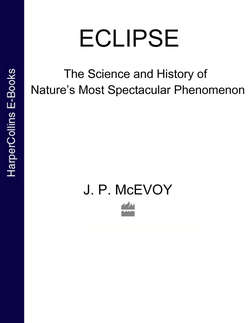Eclipse: The science and history of nature's most spectacular phenomenon

Реклама. ООО «ЛитРес», ИНН: 7719571260.
Оглавление
J. McEvoy P.. Eclipse: The science and history of nature's most spectacular phenomenon
COPYRIGHT
DEDICATION
CONTENTS
PROLOGUE. Darkness at Noon: Baja Mexico, 11 July 1991
UNDERSTANDING AN ECLIPSE
APPARENT MOTION OF THE SUN AND THE MOON: THE CELESTIAL SPHERE
THE MOON AND THE EARTH: PHASES
A PENNY IN YOUR EYE: A DIY ECLIPSE
TYPES OF SOLAR ECLIPSE
THE LINE OF NODES AND THE ECLIPSE SEASON
THE ECLIPTIC LIMIT
THE FUTURE OF THE TOTAL SOLAR ECLIPSE
THE BABYLONIANS, CHRONICLERS OF ECLIPSES
CLAY FROM BAGHDAD
OLD BABYLONIAN PERIOD
CELESTIAL OMENS AND DIVINATION
THE ECLIPSE ARCHIVE FROM BABYLON
DISCOVERIES OF LATE BABYLONIAN ASTRONOMY
THE DECLINE OF BABYLON
THE EARTH’S ROTATION
THE SAROS CYCLE: THE 6585-DAY COINCIDENCE
COUNTING THE DAYS
THE ECLIPTIC LIMIT AND THE SAROS CYCLE
SIZE AND DURATION OF A SAROS SERIES
SAROS 136
ANCIENT PREDICTIONS OF ECLIPSES: CONTROVERSIES
STONEHENGE ASTRONOMY
EARLY GREEK ASTRONOMY AND SOLAR ECLIPSES
TRACKING A SOLAR ECLIPSE
A BRIEF HISTORY OF ECLIPSE PATHS
THE ECLIPSAREON
ON THE SUNNY SIDE OF THE STREET
WHERE ON EARTH IS THE MOON’S SHADOW?
TOTALITY: HOW LONG?
THE SUN’S SURFACE: VICTORIAN SOLAR ECLIPSES
ECLIPSES OF THE SUN: THE SOLAR CORONA AND PROMINENCES
SPECTROSCOPY AND THE SOLAR ECLIPSE
INDIA: THE SOLAR ECLIPSE OF 1868
A NEW ELEMENT ON THE SUN
CONFIRMING GENERAL RELATIVITY. The Eclipse of 29 May 1919
EINSTEIN AND EDDINGTON
SUNLIGHT REACHES THE MOON (see page)
THE PRINCIPLE OF EQUIVALENCE
EXPERIMENTAL CONFIRMATION
PRINCIPE: ECLIPSE OF 29 MAY 1919
THE LAST ECLIPSE OF THE MILLENNIUM. 11 August 1999
GLOSSARY
FURTHER READING
ACKNOWLEDGEMENTS
INDEX
OTHER BOOKS BY
ABOUT THE PUBLISHER
Отрывок из книги
.....
In an annular eclipse, the Moon is aligned in front of the Sun but does not completely cover the Sun’s disk because the umbra does not quite reach the Earth. It is still a striking visual effect, with sunlight streaming out from a ring around the Moon’s outer rim. This gives the eclipse its name: annular means ‘ring-like’. As in a partial eclipse, the faint solar corona is not seen in an annular eclipse, for it is overwhelmed by the bright direct sunlight from the annular ring. An annular eclipse can be demonstrated by a slight variation in the DIY demonstration. Align the penny as before, just covering the coaster, then move the penny away from your eye slightly. You will see a ring of the coaster appear around the penny. Voilà – an annular eclipse!
The fact that a central alignment can cause either a total eclipse or an annular eclipse implies that the Earth–Moon distance varies. The Moon is not always close enough to the Earth to obscure the entire face of the Sun. In fact, both the Earth–Moon distance and the Earth–Sun distance change continuously as the Earth and Moon trace out their orbits. The values given in Table 1A for these distances are averages: at a given moment their orbital distances can be more or less than these values. Consequently, the Moon is sometimes not close enough to eclipse the Sun totally, even when perfectly aligned, and an annular eclipse happens instead.
.....